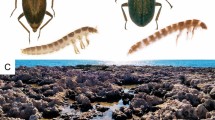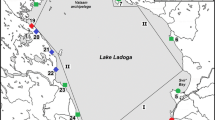Abstract
After Chelicorophium curvispinum, two other Ponto-Caspian tube-dwelling, filter-feeding amphipod species (Chelicorophium robustum and Chelicorophium sowinskyi) have colonized several catchments in Central and Western Europe in recent decades. To reveal the mechanism of niche differentiation among them, we measured the mesh sizes of their filtering apparatus and analyzed multi-habitat sampling data from the River Danube using RDA-based variance partitioning between environmental and spatial explanatory variables. Morphometric data showed a clear differentiation among the species by filter mesh size (C. curvispinum > C. robustum > C. sowinskyi). Field data also indicated the relevance of suspended matter; however, the mere quantity of suspended solids included in the analysis could not explain the abundance patterns effectively. Current velocity, substrate types, and total nitrogen content also had a non-negligible effect; however, their role in the niche differentiation of the species is not evident. In summary, differences in their filter mesh sizes indicate a niche differentiation by food particle size among the invasive Chelicorophium species, allowing their stable coexistence given sufficient size variability in their food source. Consequently, the two recent invaders increase the effectiveness of resource utilization, resulting in a more intensive benthic–pelagic coupling in the colonized ecosystems.





Similar content being viewed by others
Change history
14 August 2018
A calibration mistake caused systematic error in the microscopic measurements; all filter mesh size values should be divided by a factor of 2.56. As our conclusions were based on the inter- and intraspecific variations of the trait, this systematic error does not influence them in any way.
Filter mesh sizes ranged between 2.47 and 7.17 μm in C. curvispinum, between 1.83 and 5.09 μm in C. robustum, and between 1.03 and 2.68 μm in C. sowinskyi. Interspecific differences were estimated correctly as 1.12 μm (SE = 0.15) between C. curvispinum and C. robustum, and 1.37 μm (SE = 0.15) between C. robustum and C. sowinskyi. The correct version of Figure 2 and Table 3 are provided in this correction.
References
Altermatt F, Alther R, Fišer C, Jokela J, Konec M, Küry D, Mächler E, Stucki P, Westram AM (2014) Diversity and distribution of freshwater amphipod species in Switzerland (Crustacea: Amphipoda). PLoS ONE 9:e110328
Atkinson CL, Vaughn CC, Forshay KJ, Cooper JT (2013) Aggregated filter-feeding consumers alter nutrient limitation: consequences for ecosystem and community dynamics. Ecology 94:1359–1369
Bernauer D, Jansen W (2006) Recent invasions of alien macroinvertebrates and loss of native species in the upper Rhine River, Germany. Aquat Invasions 1:55–71
Bernerth H, Dorow S (2010) Chelicorophium sowinskyi (Crustacea, Amphipoda) ist aus der Donau in den Main vorgedrungen - Anmerkungen zur Verbreitung und Morphologie der Art. Lauterbornia 70:53–71
Bernerth H, Tobias W, Stein S (2005) Faunenwandel im Main zwischen 1997 und 2002 am Beispiel des Makrozoobenthos. Faunistisch-ökologische Untersuchungen des Forschungsinstitutes Senckenberg im hessischen Main. Hessisches Landesamt für Umwelt und Geologie, Wiesbaden, pp 15–87
Bij de Vaate A, Jażdżewski K, Ketelaars HAM, Gollasch S, Van der Velde G (2002) Geographical patterns in range extension of Ponto-Caspian macroinvertebrate species in Europe. Can J Fish Aquat Sci 59:1159–1174
Blanchet FG, Legendre P, Borcard D (2008a) Modelling directional spatial processes in ecological data. Ecol Model 215:325–336
Blanchet FG, Legendre P, Borcard D (2008b) Forward selection of explanatory variables. Ecology 89:2623–2632
Blanchet FG, Legendre P, Maranger R, Monti D, Pepin P (2011) Modelling the effect of directional spatial ecological processes at different scales. Oecologia 166:357–368
Borza P (2011) Revision of invasion history, distributional patterns, and new records of Corophiidae (Crustacea: Amphipoda) in Hungary. Acta Zool Acad Sci Hung 57:75–84
Borza P, Csányi B, Paunović M (2010) Corophiids (Amphipoda, Corophioidea) of the River Danube the results of a longitudinal survey. Crustaceana 83:839–849
Borza P, Csányi B, Huber T, Leitner P, Paunović M, Remund N, Szekeres J, Graf W (2015) Longitudinal distributional patterns of Peracarida (Crustacea, Malacostraca) in the River Danube. Fundam Appl Limnol 187:113–126
Borza P, Huber T, Leitner P, Remund N, Graf W (2017a) Current velocity shapes co-existence patterns among invasive Dikerogammarus species. Freshw Biol 62:317–328
Borza P, Huber T, Leitner P, Remund N, Graf W (2017b) Success factors and future prospects of Ponto-Caspian peracarid (Crustacea: Malacostraca) invasions: Is “the worst over”? Biol Invasions 19:1517–1532
Brönmark C, Malmqvist B (1982) Resource partitioning between unionid mussels in a Swedish lake outlet. Ecography 5:389–395
Chase JM, Leibold MA (2003) Ecological niches: linking classical and contemporary approaches. University of Chicago Press, Chicago
Cheer AYL, Koehl MAR (1987) Paddles and rakes: fluid flow through bristled appendages of small organisms. J Theor Biol 129:17–39
Dokulil MT, Donabaum U (2014) Phytoplankton of the Danube river: composition and long-term dynamics. Acta Zool Bulg Suppl 7:147–152
Fenchel T, Kofoed LH, Lappalainen A (1975) Particle size-selection of two deposit feeders: the amphipod Corophium volutator and the prosobranch Hydrobia ulvae. Mar Biol 30:119–128
Forcellini M (2012) First record of the Ponto-Caspian invasive crustacean Chelicorophium sowinskyi (Martinov, 1924) (Amphipoda, Corophiidae) in the French Rhône River. Crustaceana 85:1781–1785
Griffiths JR, Kadin M, Nascimento FJA, Tamelander T, Törnroos A, Bonaglia S, Bonsdorff E, Brüchert V, Gårdmark A, Järnström M, Kotta J, Lindegren M, Nordström MC, Norkko A, Olsson J, Weigel B, Žydelis R, Blenckner T, Niiranen S, Winder M (2017) The importance of benthic-pelagic coupling for marine ecosystem functioning in a changing world. Glob Change Biol 23:2179–2196
Hellmann C, Worischka S, Mehler E, Becker J, Gergs R, Winkelmann C (2015) The trophic function of Dikerogammarus villosus (Sowinsky, 1894) in invaded rivers: a case study in the Elbe and Rhine. Aquat Invasions 10:385–397
Hering D, Moog O, Sandin L, Verdonschot PF (2004) Overview and application of the AQEM assessment system. Hydrobiologia 516:1–20
Higgins SN, Vander Zanden MJ (2010) What a difference a species makes: a meta-analysis of dreissenid mussel impacts on freshwater ecosystems. Ecol Monogr 80:179–196
Jones LA, Ricciardi A (2005) Influence of physicochemical factors on the distribution and biomass of invasive mussels (Dreissena polymorpha and Dreissena bugensis) in the St. Lawrence River. Can J Fish Aquat Sci 62:1953–1962
Kang C-K, Choy EJ, Hur Y-B, Myeong J-I (2009) Isotopic evidence of particle size-dependent food partitioning in cocultured sea squirt Halocynthia roretzi and Pacific oyster Crassostrea gigas. Aquat Biol 6:289–302
Kelleher B, Bergers PJM, Van den Brink FWB, Giller PS, Van der Velde G, Bij de Vaate A (1998) Effects of exotic amphipod invasions on fish diet in the Lower Rhine. Arch Für Hydrobiol 143:363–382
Labat F, Piscart C, Fontan B (2011) First records, pathways and distributions of four new Ponto-Caspian amphipods in France. Limnologica 41:290–295
Lefcheck JS (2016) piecewiseSEM: Piecewise structural equation modelling in R for ecology, evolution, and systematics. Methods Ecol Evol 7:573–579
Legendre P, Gallagher ED (2001) Ecologically meaningful transformations for ordination of species data. Oecologia 129:271–280
Legendre P, Legendre LF (2012) Numerical ecology, 3rd English edition edn. Elsevier, Amsterdam
Lesser MP, Shumway SE, Cucci T, Smith J (1992) Impact of fouling organisms on mussel rope culture: interspecific competition for food among suspension-feeding invertebrates. J Exp Mar Biol Ecol 165:91–102
Møller LF, Riisgård HU (2006) Filter feeding in the burrowing amphipod Corophium volutator. Mar Ecol Prog Ser 322:213–224
Nakagawa S, Schielzeth H (2013) A general and simple method for obtaining R 2 from generalized linear mixed-effects models. Methods Ecol Evol 4:133–142
Noordhuis R, van Schie J, Jaarsma N (2009) Colonization patterns and impacts of the invasive amphipods Chelicorophium curvispinum and Dikerogammarus villosus in the IJsselmeer area, The Netherlands. Biol Invasions 11:2067–2084
Oksanen J, Blanchet FG, Kindt R, Legendre P, Minchin PR, O’Hara RB, Simpson GL, Solymos P, Stevens MHH, Wagner H (2017) Vegan: Community Ecology Package. R package version 2.4-3. http://CRAN.R-project.org/package=vegan
Pinheiro J, Bates D, DebRoy S, Sarkar D, R Core Team (2016) nlme: linear and nonlinear mixed effects models. R package version 3.1-125, http://CRAN.R-project.org/package=nlme
R Core Team (2016) R: a language and environment for statistical computing. R Foundation for Statistical Computing, Vienna, Austria. http://www.R-project.org/
Riisgård HU, Larsen PS (2010) Particle capture mechanisms in suspension-feeding invertebrates. Mar Ecol Prog Ser 418:255–293
Rohlf FJ (2015) tpsDig, Digitize Landmarks and Outlines, version 2.22. Department of Ecology and Evolution, State University of New York, Stony Brook
Shimeta J, Jumars PA (1991) Physical mechanisms and rates of particle capture by suspension-feeders. Oceanogr Mar Biol Annu Rev 29:l–257
Sousa R, Novais A, Costa R, Strayer DL (2014) Invasive bivalves in fresh waters: impacts from individuals to ecosystems and possible control strategies. Hydrobiologia 735:233–251
Svensson JR, Marshall DJ (2015) Limiting resources in sessile systems: food enhances diversity and growth of suspension feeders despite available space. Ecology 96:819–827
Van den Brink FWB, Van der Velde G, Bij de Vaate A (1993) Ecological aspects, explosive range extension and impact of a mass invader, Corophium curvispinum Sars, 1895 (Crustacea: Amphipoda), in the Lower Rhine (The Netherlands). Oecologia 93:224–232
Van der Velde G, Paffen BGP, Van den Brink FWB, Bij de Vaate A, Jenner HA (1994) Decline of zebra mussel populations in the Rhine. Naturwissenschaften 81:32–34
Van Riel MC, Van der Velde G, Rajagopal S, Marguillier S, Dehairs F, Bij de Vaate A (2006) Trophic relationships in the Rhine food web during invasion and after establishment of the Ponto-Caspian invader Dikerogammarus villosus. Hydrobiologia 565:39–58
Wallace JB, Webster JR, Woodall WR (1977) The role of filter feeders in flowing waters. Arch Für Hydrobiol 79:506–532
Zhang X, Liu Z, Jeppesen E, Taylor WD, Rudstam LG (2016) Effects of benthic-feeding common carp and filter-feeding silver carp on benthic-pelagic coupling: implications for shallow lake management. Ecol Eng 88:256–264
Zuur AF, Ieno EN, Walker NJ, Saveliev AA, Smith GM (2009) Mixed effects models and extensions in ecology with R. Springer, New York
Acknowledgements
Joint Danube Survey 3 was organized by the International Commission for the Protection of the Danube River (ICPDR). We would like to thank everyone involved in the organization, field work, and evaluation of the survey for their effort, and Zsuzsanna Trábert for her assistance during the microscopy. This work was supported by the MARS project (Managing Aquatic ecosystems and water Resources under multiple Stress) funded by the European Union under the 7th Framework Programme, grant agreement no: 603378, and the Economic Development and Innovation Operational Programme (GINOP) 2.3.2-15-2016-00019 grant. Péter Borza was supported by the Scholarship of the Scholarship Foundation of the Republic of Austria for Post-docs from October 2013 until March 2014 (funding organization: Österreichischer Austauschdienst GmbH on behalf of and financed by the Scholarship Foundation of the Republic of Austria).
Author information
Authors and Affiliations
Corresponding author
Additional information
Handling Editor: Piet Spaak.
Electronic supplementary material
Below is the link to the electronic supplementary material.
Rights and permissions
About this article
Cite this article
Borza, P., Huber, T., Leitner, P. et al. Niche differentiation among invasive Ponto-Caspian Chelicorophium species (Crustacea, Amphipoda, Corophiidae) by food particle size. Aquat Ecol 52, 179–190 (2018). https://doi.org/10.1007/s10452-018-9653-8
Received:
Accepted:
Published:
Issue Date:
DOI: https://doi.org/10.1007/s10452-018-9653-8




